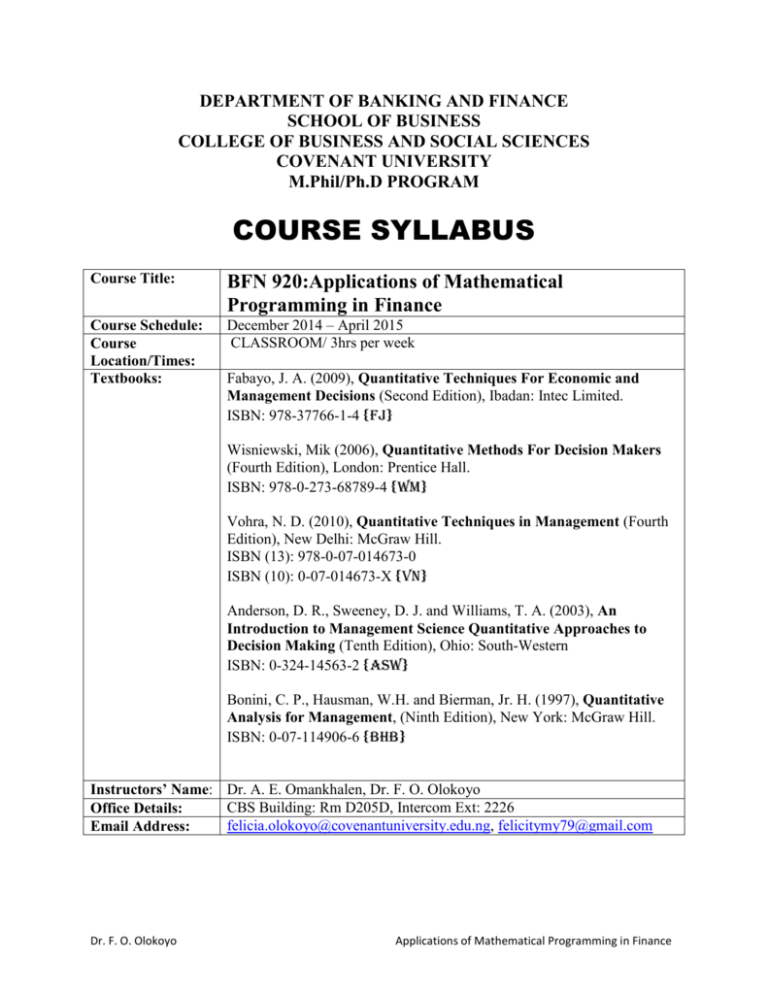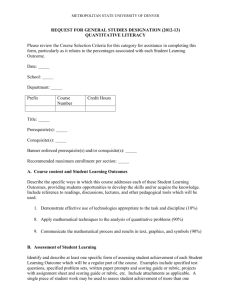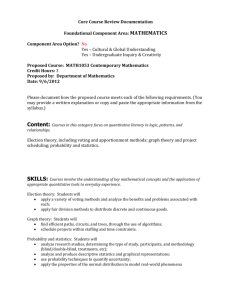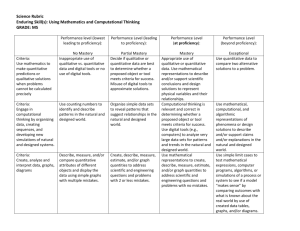Course Objectives - Department of LD
advertisement

DEPARTMENT OF BANKING AND FINANCE
SCHOOL OF BUSINESS
COLLEGE OF BUSINESS AND SOCIAL SCIENCES
COVENANT UNIVERSITY
M.Phil/Ph.D PROGRAM
COURSE SYLLABUS
Course Title:
BFN 920:Applications of Mathematical
Programming in Finance
Course Schedule:
Course
Location/Times:
Textbooks:
December 2014 – April 2015
CLASSROOM/ 3hrs per week
Fabayo, J. A. (2009), Quantitative Techniques For Economic and
Management Decisions (Second Edition), Ibadan: Intec Limited.
ISBN: 978-37766-1-4 {FJ}
Wisniewski, Mik (2006), Quantitative Methods For Decision Makers
(Fourth Edition), London: Prentice Hall.
ISBN: 978-0-273-68789-4 {WM}
Vohra, N. D. (2010), Quantitative Techniques in Management (Fourth
Edition), New Delhi: McGraw Hill.
ISBN (13): 978-0-07-014673-0
ISBN (10): 0-07-014673-X {VN}
Anderson, D. R., Sweeney, D. J. and Williams, T. A. (2003), An
Introduction to Management Science Quantitative Approaches to
Decision Making (Tenth Edition), Ohio: South-Western
ISBN: 0-324-14563-2 {ASW}
Bonini, C. P., Hausman, W.H. and Bierman, Jr. H. (1997), Quantitative
Analysis for Management, (Ninth Edition), New York: McGraw Hill.
ISBN: 0-07-114906-6 {BHB}
Instructors’ Name: Dr. A. E. Omankhalen, Dr. F. O. Olokoyo
CBS Building: Rm D205D, Intercom Ext: 2226
Office Details:
felicia.olokoyo@covenantuniversity.edu.ng, felicitymy79@gmail.com
Email Address:
Dr. F. O. Olokoyo
Applications of Mathematical Programming in Finance
COURSE DESCRIPTION ______________________________________________________
This course treats at the theoretical and quantitative level the concept of mathematical
programming models and techniques as applicable in finance for effective decision making. As
decision making especially at organizational levels can be complex and has becoming
increasingly so in contemporary times, decisions have to be based largely on quantitative
information(facts or data) which have to be collected, collated, summarized, presented and
analysed in ways that, inter-alia, show relationships, indicate trends and show rates of
changes in various relevant variables. Quantitative analysis involves the application of
scientific techniques to different complex problems emanating from the control and
management of large interactive system of men, machines, materials and money in
virtually all fields of human endeavours.
Course Objectives
Introduction to Quantitative Analysis
Establish the meaning and nature of quantitative analysis
Identify the problems requiring quantitative analysis
Evaluate the phases of quantitative analysis
Examine the application areas of quantitative analysis
Mathematical Modeling in Finance
To understand the basic concepts in mathematical programming with special emphasis on
the optimization models.
Discuss the concept of model building
Identify the classification of models and the different types of models
Assess the relevance of quantitative models
Examine the process of financial model building
Mathematical Programming Models (MPMs)
To have an in-depth knowledge of the categories of the mathematical programming
models of portfolio selection viz-a-vis:
Linear Programming Model –Investment Decisions under Condition of Certainty
Non-linear Programming Model – Portfolio Selection
Goal Programming Model – Financial Budgeting
Integer Programming Model – Resource Allocation Problem
Mathematical Theory of Decision Making and Capital Budgeting
To appreciate various mathematical theories of decision making with more emphasis on:
Decision analysis and payoff matrix
Sequencing theory for project construction
Queuing theory and design and games theory
To have an understanding of how to adapt portfolio selection to capital budgeting with
inventory and cash management models
Dr. F. O. Olokoyo
Applications of Mathematical Programming in Finance
Point Values for the Course
ASSIGNMENTS
Seminar paper
Journal Articles Review
Final Exam
Total
POINTS
15%
15%
70%
100%
How Points and Percentage Equate to Grades
70 and Above
A
60 – 69
B
50 – 59
C
45 – 49
D
44 and Below
F
COURSE STRUCTURE
(A) Seminar Paper
Each student is expected to identify a research topic and submit to the instructor for approval.
Once the topic is approved by the instructor, the student is expected to carry out a good and
acceptable research work prior to the conclusion of the course lectures. The research work will
be carried out with the guidance of the course instructor and should be published.
(B) Journal Articles Review
Students are expected to rely on textbooks on quantitative analysis/techniques to get in-depth
background knowledge of the subject matter for each module. The students then proceed to
review the articles selected for each module by the instructor. The main requirement for this
assignment is the students’ ability to read the selected journal papers and do a good job of
reviewing/critiquing them. Each student is expected to read and write a 3 pages review of each
journal article. All articles in each module should be reviewed and the reports spiral-binded
together to be submitted to the instructor.
(C) Final Exam
The students must prepare adequately for the exam which is a very important part of the course.
The examination materials will be drawn from the classroom lectures, term paper as well as
journal articles. It is therefore of paramount importance that students pay attention to all details.
Dr. F. O. Olokoyo
Applications of Mathematical Programming in Finance
Module 1
Introduction to Quantitative Analysis
Establish the meaning and nature of quantitative analysis
Identify the problems requiring quantitative analysis
Evaluate the phases of quantitative analysis
Examine the application areas of quantitative analysis
Textbook Coverage:
{FJ}: Chapter One – Pages 1 - 15
{VN}: Chapter One – Pages 1 – 17
{WM}: Chapter One – Pages 1 – 15
{ASW}: Chapter One – Pages 1 – 12
ASSIGNMENTS______________________________________________________________
Journal Papers Review:
1. Decision Making with Quantitative Tools
http://www.cliffsnotes.com/WileyCDA/CliffsReviewTopic/Decision-Maki ng-withQuantitativeTools.topicArticleId-8944,articleId-8866.html
2. Steps for Solving Quantitative Problems and evolving techniques
go.hrw.com/resources/go_sc/ssp/HUGPS037.PDF
Dr. F. O. Olokoyo
Applications of Mathematical Programming in Finance
Module 2
Mathematical Modeling in Finance
To understand the basic concepts in mathematical programming with special emphasis on
the optimization models.
Discuss the concept of model building
Identify the classification of models and the different types of models
Assess the relevance of quantitative models
Examine the process of financial model building
Textbook Coverage:
{VN}: Chapter Nineteen – Pages 982 – 1005
{ASW}: Chapter One – Pages 7 – 22
{BHB}: Chapter One – Pages 2 – 38
ASSIGNMENTS______________________________________________________________
Journal Papers Review:
1. Mathematical
Models for Financial Management
by
M.
H.
Miller,
www.chicagobooth.edu/.../1302AC86C73446F0B7920294904E19F2.P...
2. Influence of Mathematical Models in Finance on Practice: Past, Present and Future [and
Discussion], Robert C. Merton, R. V. Simons and A. D. Wilkie, pp.451- 463,
www.jstor.org/stable/54356
Dr. F. O. Olokoyo
Applications of Mathematical Programming in Finance
Module 3
Mathematical Programming Models (MPMs)
To have an in-depth knowledge of the categories of the mathematical programming
models of portfolio selection viz-a-vis:
Linear Programming Model –Investment Decisions under Condition of Certainty
Non-linear Programming Model – Portfolio Selection
Goal Programming Model – Financial Budgeting
Integer Programming Model – Resource Allocation Problem
Textbook Coverage:
{FJ}: Chapter Thirteen – Pages 452 – 497
{VN}: Chapters Two – Seven – Pages 18 – 404
Chapter Sixteen – Pages 842 -870
{WM}: Chapter Eleven – Pages 399 – 429
{ASW}: Chapters Two-Five and Eight - Pages 31 – 224, 368 - 410
{BHB}: Chapter Two - Four – Pages 40 – 184
ASSIGNMENTS______________________________________________________________
Journal Papers Review:
1. A Mathematical Programming Model to Global Supply Chain Management: Conceptual
Approach and Managerial Insights by Panos Kouvelis and Meir J. Rosenblatt
apps.olin.wustl.edu/workingpapers/pdf/2003-03-002.pdf
2. Mathematical Programming: An Overview web.mit.edu/15.053/www/AMP-Chapter-01.pdf
Dr. F. O. Olokoyo
Applications of Mathematical Programming in Finance
Module 4
Mathematical Theory of Decision Making and Capital Budgeting
To appreciate various mathematical theories of decision making with more emphasis on:
Decision analysis and payoff matrix
Sequencing theory for project construction
Queuing theory and design and games theory
To have an understanding of how to adapt portfolio selection to capital budgeting with
inventory and cash management models
Textbook Coverage:
{FJ}: Chapter Fourteen – Pages 506 – 526
Chapter Sixteen – Pages 575 – 619
Chapter Seventeen – Pages 625 - 679
{VN}: Chapter Eight – Pages 414 – 442
Chapter Nine – Pages 442 -870
Chapter Ten – Pages 522 – 561
Chapter Thirteen – Pages 696 – 743
Chapter Fifteen – Pages 796 – 831
{WM}: Chapter Six – Pages 180 – 200
{ASW}: Chapters Eleven – Pages 479 – 523
Chapter Twelve – Pages 525 – 553
Chapter Fourteen – Pages 624 - 684
{BHB}: Chapter Eight – Pages 332 - 377
Chapter Nine – Pages 380 – 407
ASSIGNMENTS______________________________________________________________
Journal Papers Review:
1. Groups Discussing Inventory Quantitative Model of Decision Making – Yahoo Groups
http://groups.yahoo.com/phrase/inventory-quantitative-model-of-decision-making
2. Solving Of Waiting Lines Models in the Bank Using Queuing Theory Model the Practice
Case: Islami Bank Bangladesh Limited, Chawkbazar Branch, Chittagong by Mohammad
Shyfur Rahman chowdhury, Mohammad Toufiqur Rahman and Mohammad Rokibul Kabir.
www.iosrjournals.org/ccount/click.php?id=5088
Dr. F. O. Olokoyo
Applications of Mathematical Programming in Finance







